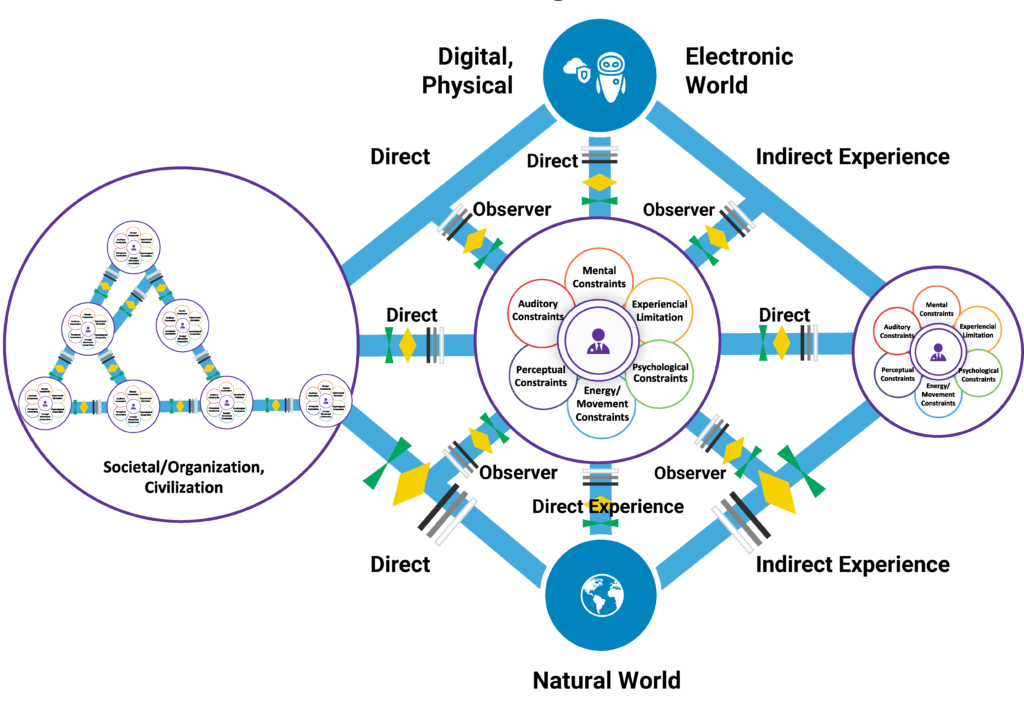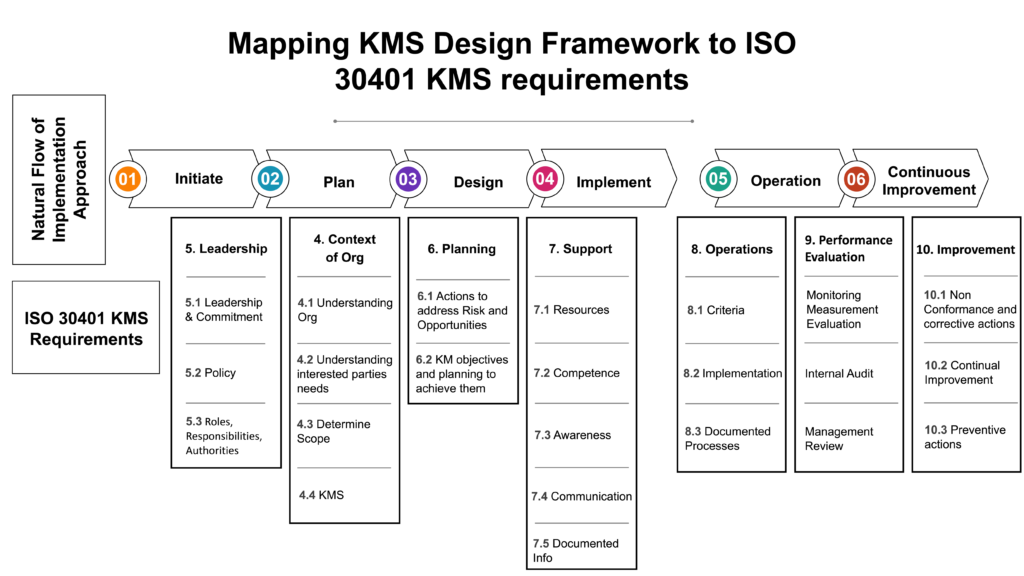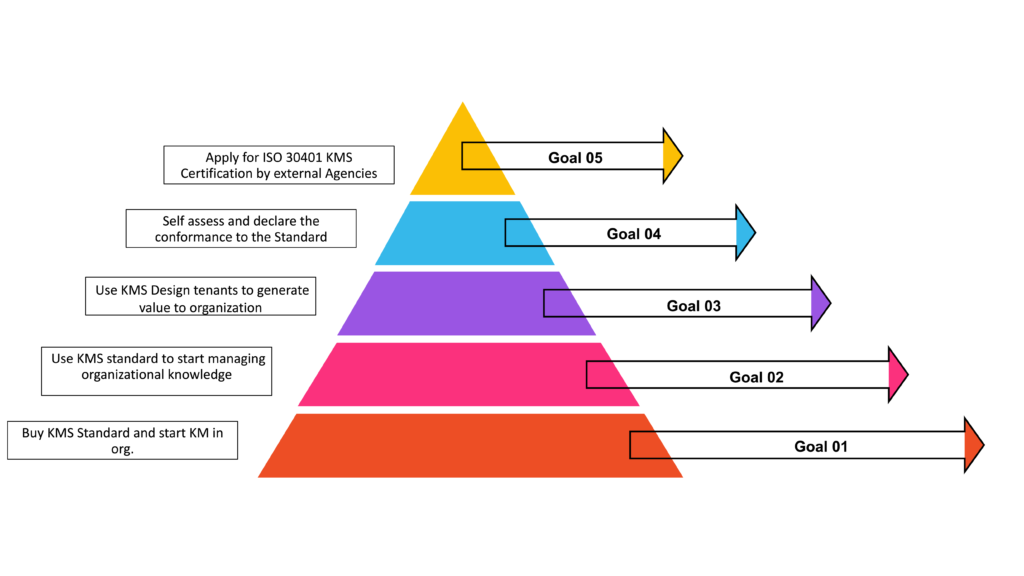Knowledge Management standards – Facilitating organization for the paradigm shift
Santhosh Shekar


◀︎ im Heft blättern ▶︎
In this paper, we examine the existing knowledge challenges and the continental shift at the workplace and working culture due to the pandemic, which has increased social distancing and created silos due to new way of working. In these times of uncertainty, KM practices are critical for increasing overall organizational resilience.
With the creation of ISO 30401 KMS standard (1)a void has been fulfilled for individuals and organizations as KM body of knowledge. It is essential to manage, execute and support KM projects and initiatives to establish a collaborative and resilient work environment. The paper throws light on some key elements of KM standard, steps to implement and ways to Map existing KM to ISO requirements.
Background
The Pandemic has disrupted a hundred-plus year of management theories and work cultures, as well as causing current organizations to come out with work-arounds in order to adapt to this new paradigm shift.
For all these years, the organizations had social spaces in their offices/work areas that provided a space for conversations among individuals and teams, where interaction between employees was much easier and promoted informal conversations and enhanced the effectiveness of team building. However, the pandemic has disrupted the entire social fabric of every organization in the world. Although each nation is beginning to recover, however, it is still unclear what the future holds for humanity.
The pandemic has induced new barriers within the work environment to work in the Isolation of 4 walls or work-from-home options has created huge distance between individuals within teams and organizations. Even though ICTs (2)are helping to bridge the gap, the human need for social spaces to communicate and collaborate will never be replaced overnight. In practice, building knowledge infrastructure (4) based on each knowledge worker’s (3) role are very critical as much as providing physical infrastructure. For examples: If there are new joiners to the team, it is very challenging for a new employee to understand the working environment when onboarded online and work from home from day one. In other example, most of the workshops and project meetings now take place virtually, though these helps to get transactional matters sorted, but real-time communication and relationship building gets diminished, when compared to teams working together in common social workspaces.
The World of Knowledge Constraints
The knowledge flows (5) between two individuals can have multiple outcomes based on the self-knowledge constraints (6) and intentions they share with one another. There are conversations that are empowering, some are not in a given situation and few are just transactional. When we consider the extrapolation of all the transactions and the knowledge Flow barriers between Two teams or more, between individual and various domains like digital domain (Computer, Mobile, etc.), societal (groups, functions, states, etc.), physical (meeting rooms, workspaces etc.) and natural domains (physical spaces etc.) provides us the understanding of inherent difficult nature of knowledge flows. The world of knowledge constraints (6a) Model provides us with a sense of complexities in every organization, societies and nations as to why managing knowledge is so complex and does not happen naturally.
Hence, it is essential for every organization to proactively or deliberately cultivate the knowledge management philosophy or culture in order to foster robust collaboration (7), knowledge exchange (8), knowledge retentions (9) and knowledge leadership in this „world of the knowledge constraints.
With the world of knowledge constraints in the background, we get fair idea of numerous barriers at every level of the organization, including individuals, teams, projects, functions, departments, markets, clients, customers, and management level. Organizations have started to reinvent themselves into new way of working. However creating structured way of developing knowledge spaces, sharing cultures and new work practices are the need of this time. It may not be possible for every organization to adopt to new practices.
A Need for Knowledge Management
When there is enterprise level focus with strong leadership to develop a strong knowledge-sharing environment, a strong synergy can be created by bringing people together and make organizations more resilient.
To aid this kind of organizational transformation, Knowledge Management practices will play very crucial role in empowering individuals and management to build learning and resilient organizations. Knowledge workers are at the center of knowledge-based economy. Knowledge management as a profession has evolved for 25+ years now; however, it is still an enigma for many organizations and Individuals when it comes to practical adaptation.
The KM is not common across all companies globally. However, in this pandemic, it has become imperative for every organization to start thinking on these lines, to effectively manage their critical knowledge. Hence, more and more organization need to realize and start adopting Knowledge management formally. If someone wants to start KM formally, they will need a reference/good practice to plan out KM implementation in their teams/organizations in a structured way. The common method for organizations is to benchmark KM practices in other companies and see what works and what doesn’t. However, such exercise doesn’t provide insights into internal functioning of KM team or their good practices (view of entire KM Lifecycle). And there are case studies and papers written on KM – IT tools, and pitfalls of KM-IT systems, however it falls short of industry best practices requirement, for example: something equivalent or close to PMBOK (10) or ITIL (11) body of knowledge.
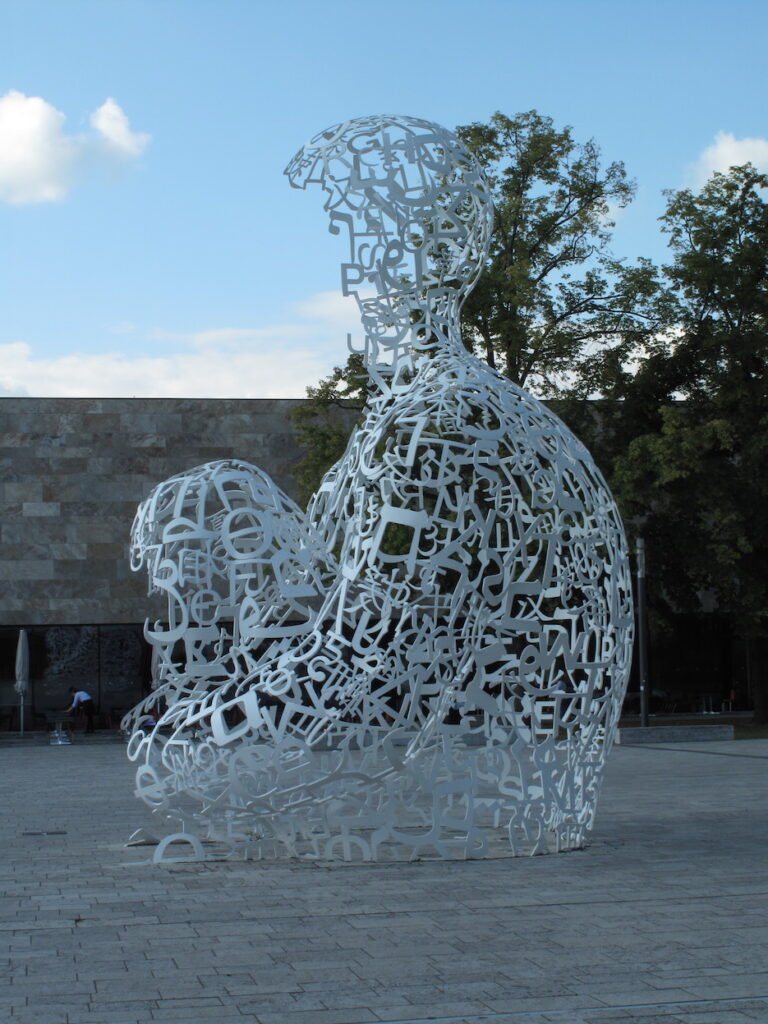
Body of Knowledge: sculpture (8 meters high, painted stainless steel) by Catalan artist Jaume Plensa (born in Barcelona in 1955) on the campus of Goethe University in Frankfurt am Main. The image in the header of the article shows the view from inside in direction of the sculpture’s head. (photos: St. Zillich)
KM standard – the first globally accepted body of work
To fill this void, in 2018, ISO 30401 knowledge management system requirement standard was published. It was the first standard created by KM Practitioners representing different continents. It provides us with a body of knowledge or reference guide that can be utilized by individuals and organizations to manage the entire KM lifecycle in any kind of organization, including government, Industries, medium and small scale organizations, agencies, NGOs and academic institutions, etc. This is also the first globally accepted body of work on KM across many countries.
In this time of Pandemic, if any individual or organization wishes to understand management of Knowledge, then ISO 30401 KMS might be the first stop to start their journey. The standard provides systematic way of doing KM based on their requirements, which followed will accelerate KM project executions. The Standard does not define a solution but provides an ontological framework or management framework that can be applied to any organizations to solve complex business challenges in knowledge domain.
ISO 30401 KMS requirements Functional Mapping
The block diagram “ISO 30401 KMS Functional Diagram-1” (6b) illustrates one possible way of application. The blocks are interchangeable and can be expanded based on the maturity of organizational knowledge management. There are knowledge entities that would be doing KM in different names, but might have no formal KM. Then there are companies that might be doing KM in pockets, and then there are companies who would have strong mandate for KM by management and now want to implement the standards. The standard could be applicable to teams/organizations/societies in whichever phase they are in the life cycle of knowledge evolution.
10 Steps towards achieving ISO 30401 KMS requirements
There are infinite ways to interpret the Standards and can be customized to one’s organizational need. One such generic methodology has been represented below. The 10-step guide (6c) presents how to roll out the KM system newly based on ISO 30401 KMS standards. The entire Lifecycle of KM is presented in simple steps.
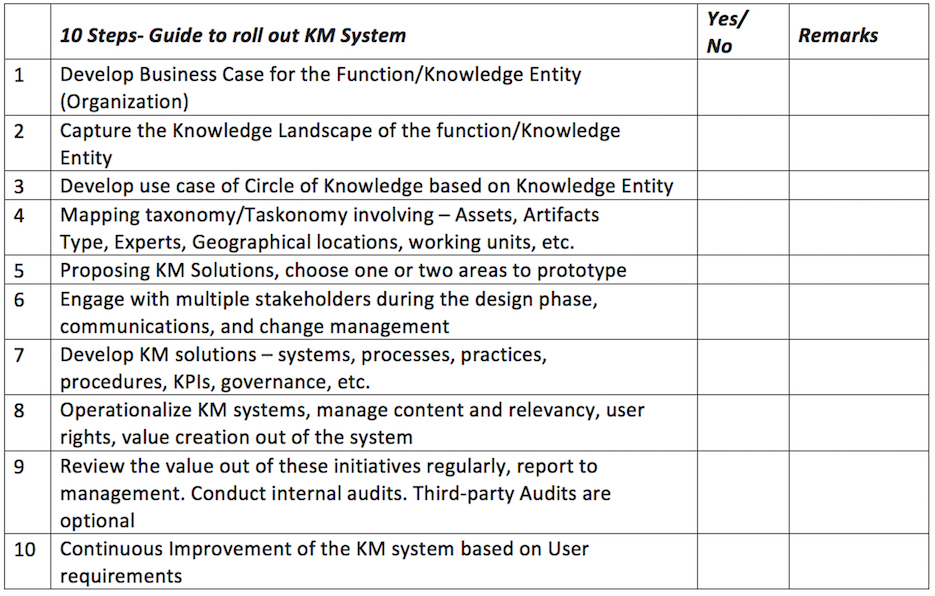
The 10-step guide (6c) presents how to roll out the KM system newly based on ISO 30401 KMS standards. (click to enlarge)
Further to these steps, individuals can also look at the Block diagram and understand how to map KM standard requirements to their KM Programs/projects. The phases define the natural way of executing projects in the organization, which in turn is mapped to requirement clauses.
The requirement follows that the organization develop appropriate KM policy and strategy by the management and establish KM team with right competencies and skills, this is the critical element that becomes essential for the long-term sustenance of KM in any kind of organization.
KM Functions/teams need to work with the interested parties to define business challenges and then define knowledge objectives. These objectives will then help in the definition of knowledge challenges and then develop or design custom KM solutions to fit the purpose.
The core of the standard defines the need for Knowledge development, Conveyance, transformation, and enablers in an organization and provides ontological guide, but never dictate the solution.
To gain more practical understanding of ISO 30401, consider few generic knowledge areas (example) that are common across all the industries regardless of their size and type of the segments;
- Knowledge Assets Management,
- Lesson Learned Management,
- Onboarding & Knowledge Retention, and
- Communities of Practices.
The methods and techniques are completely up to the organization to design appropriate KM solutions, technologies, and practices. These programs and projects have to be measured from time to time and infer the effectiveness of these KM systems and report to the management.
Other attributes of the standard are that it also offers organizations an external assessment or audit as a third-party evaluation to identify the areas working well and the KM areas that are not working well based on the KM standards requirement Accordingly, an organization can declare compliance based on these requirements without even undergoing a third-party audit but can fulfill the requirements through internal audits of its KM programs.
Formalizing KM – Globally
One of the Call for Actions for all organizations is to include knowledge management as a formal discipline or function within the organization to address the new culture brewing across the world.
It is recommended that organizations without formal knowledge management should start KM. Organizations who already have KM should start to aligning to the ISO 30401 KMS requirements and declare that they are ISO 30401 KMS compliant after conducting Internal Audits. Organizations who have declared KMS compliance can go for third party certification, so that it can be audited and after evaluation can get accreditation of ISO 30401 KMS certification for three years, after which they will need to renew it.
There are millions of organizations without formal KM initiatives at this point of time. As more and more organizations will become aware of the necessity of building knowledge infrastructure based on knowledge worker roles, more and more employees will feel included and nurtured within the new norm of working from home options or remote working.
The individuals who see opportunity should start stand-alone KM initiatives based on their needs, regardless of organizational formal KM drive. Standard could also aid such implementation.
In order to adapt to the new possibilities of the post-pandemic world, organizations and individuals should examine the ISO 30401 KMS standard and start implementing KM programs and create knowledge management strategies. ![]()
References
(1) ISO – International organization for Standardization, https://www.iso.org/standard/68683.html
(2) ICT, https://en.wikipedia.org/wiki/Information_and_communications_technology
(3) knowledge worker, Peter Drucker, The Effective Executive, 1966; https://en.wikipedia.org/wiki/Knowledge_worker
(4) Knowledge Infrastructure, Knowledge Infrastructure- Sivan, Yesha. (2000). Nine Keys to a Knowledge Infrastructure: A Proposed Analytic Framework for Organizational Knowledge Management. 495-500
(5) Knowledge Flow, Mastering Organizational Knowledge Flow- How to make Knowledge Sharing work by Frank Leistner.; Serenko, A., Bontis, N. and Hardie, T. (2007), “Organizational size and knowledge flow: a proposed theoretical link”, Journal of Intellectual Capital, Vol. 8 No. 4, pp. 610-627
(6) Santhosh Shekar, Design Knowledge Management System, 2021
a. World of Knowledge Constraints, Page 32
b. ISO 30401 Functional Diagram, page 16
c. 10 Steps- Guide to roll out KM System, page 76
d. KMS Global Adaptability Steps, page 188
(7) Collaboration, Experts and Collaboration Systems- Wenger, Etienne & McDermott, Richard & Snyder, William. (2002). Cultivating Communities of Practice: A Guide to Managing Knowledge.
(8) Knowledge Exchange, Knowledge Exchange Facilitation- Facilitator Guidelines (stanford.edu) | https://web.stanford.edu/group/resed/resed/staffresources/RM/training/facilguide.html
(9) Knowledge Retention- Knowledge Retention- Levy, M. (2011), “Knowledge retention: minimizing organizational business loss”, Journal of Knowledge Management, Vol. 15 No. 4, pp. 582-600.
(10) PMBOK, https://www.pmi.org/pmbok-guide-standards/foundational/PMBOK
(11) ITIL, https://www.axelos.com/best-practice-solutions/itil

Santosh Shekar has been working as KM Practitioner for more than 21 years in various industries. He is the world’s second accredited ISO 30401 auditor and recently published his first critically acclaimed book titled „Design Knowledge Management System“ which is available on Amazon. For more info about the book visit http://iso30401kms.com . Santhosh works as KM architect at PDO, Oman. His passion for KM has led him to propagate KM and KM standard by establishing KnowledgeDesk a platform offering multiple KM services like KM experts interviews KNOWLEDGEWebCast, KM and KM standard awareness etc. You can follow his work and collaborate on km and KM standards. http://www.santhoshshekar.com

◀︎ im Heft blättern ▶︎
About this contribution Text: Santhosh Shekar · Editors: Stefan Zillich, Andreas Matern · 2 photos: Stefan Zillich; images 1-4: Santhosh Shekar · Editorial Design: Stefan Zillich, re:Quest Berlin · Thanks to Stephanie Barnes who initiated contact and cooperation with the author · published in: Kuratiertes Dossier „Wissensmanagement – New Normal“, online magazine startpage – order a copy of the printed edition · About the edition „Das Kuratierte Dossier“ · © authors / GfWM e. V. 2021 · contact the editors

